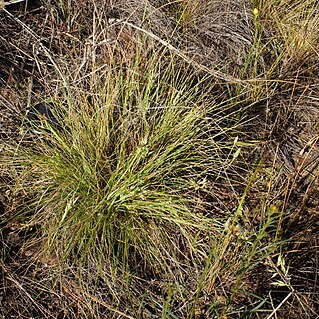Small hoary-leaved tufts; leaves « culms; branching intravaginal. Leaf-sheath light purple, of basal leaves glabrous, of culm leaves abundantly long-hairy; apical tuft of hairs to 3.5 mm. Ligule 0.7 mm. Leaf-blade to 9 cm, ± flat, to 2 mm wide, densely and conspicuously covered in long stiff hairs, margins thickened, scabrid. Culm to 45 cm, internodes glabrous but long-hairy below inflorescence. Panicle short, broad, to 4.5 cm, of few large spikelets on short pedicels; rachis and pedicels covered in long fine hairs. Spikelets 5-8-flowered, awns exserted from glumes. Glumes purplish, lanceolate, obtuse, 10-14 mm, ± equal; lower 9-11-nerved, upper 9-nerved, occasionally long scattered hairs. Lemma 3.0-3.7 mm, 9-nerved, upper and lower rows of hairs very dense, continuous, upper hairs « lemma lobes, marginal tufts of lower row overlapping upper but central tufts shorter, glabrous, shining elsewhere; lobes 8-9.8 mm, tapering to long conspicuous awns, adaxially scattered short hairs and two thick longer tufts near awn sinus; central awn 12.8-15 mm, column 4 mm » upper lemma hairs. Palea 3.3-4 mm, obovate-oblong, broad, apex rounded, < upper lemma hairs, interkeel hairs few and very short at base, margins with 1-2 long fine hairs. Callus 0.8-1 mm, thick marginal hair tufts overlapping lower lemma hairs. Rachilla 0.1 mm. Anthers 0.4, and 0.7-0.9 mm. Caryopsis c. 1.5 mm; embryo 0.6 mm; hilum 0.5 mm.
More
Plants caespitose; innovation buds intravaginal. Culms 19–60 cm high. Inflorescences linearlanceolate. Spikelets 11–18 mm long, with 4–7 florets. Glumes slightly to substantially exceeding florets; lower glume 10.2–19 mm long, c. 4 mm wide. Lemma: body 2.5–4 mm long, with straight margins, glabrous between the rows of tufts; both rows of hair tufts complete, with lower row not reaching or (in subalpine form) equalling upper row; lobes longer than (or rarely as long as) body, but not twice as long; setae 3–8.5 mm long, longer than lobes, with upper lobe and seta very gradually curving outwards; awn 9.7–20.8 mm long, exceeding setae; awn column tightly twisted, shorter than or equalling lobes. Palea ovate, 3–5.4 mm long, broad, 1–3 times as long as wide, slightly exceeding lemma sinus, glabrous between keels. Anthers 0.5–3 mm long. Caryopsis 1.6–2 mm long.

